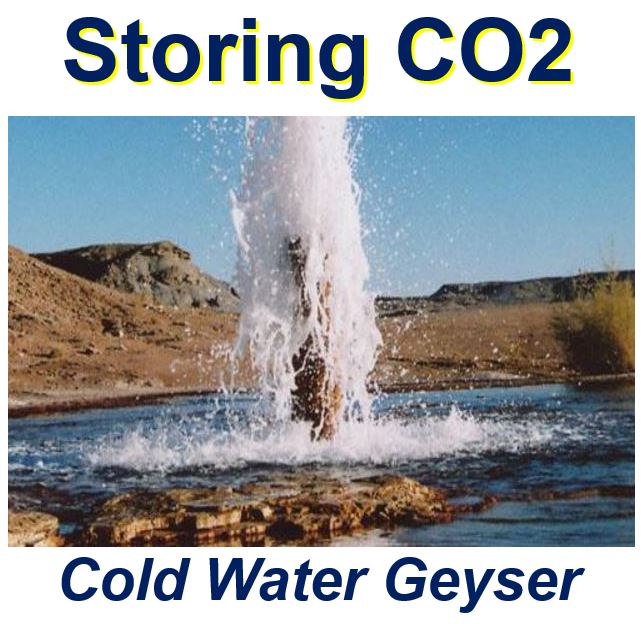We are emitting all this CO2 (carbon dioxide), a greenhouse gas from coal and gas-fired power stations that will continue warming up our planet, and have been reluctant to store it underground for fear that it might corrode the rock around it and leak out. A new study found that this does not occur for over 100,000 years.
In other words, storing carbon dioxide deep underground appears to be a safe way to prevent it from being released into the atmosphere.
A team of scientists from the UK, USA, Germany and The Netherlands studied natural-occurring 100,000 year-old CO2 reservoirs and found no significant corroding of cap rock. This means that the greenhouse gas does not appear to have leaked back out, i.e. we could probably safely store our carbon emissions underground.
 A cold water geyser driven by CO2 erupting from an unplugged oil exploration well drilled in 1936 into a natural CO2 reservoir in Utah. (Image: cam.ac.uk. Credit: Professor Mike Bickle)
A cold water geyser driven by CO2 erupting from an unplugged oil exploration well drilled in 1936 into a natural CO2 reservoir in Utah. (Image: cam.ac.uk. Credit: Professor Mike Bickle)
Storing CO2 underground becomes a viable option
If we stored carbon dioxide in reservoirs deep below Earth’s surface, it would remain there safely for a very, very long time, the researchers believe.
The authors say their findings demonstrate the viability of a process known as CCS (carbon capture and storage) as a promising solution to reducing carbon emissions from gas-fired and coal-fired power stations.
CCS, also known as sequestration, is the process of capturing waste CO2 from large point sources such as power plants, compressing it, and pumping it more than one kilometre under the ground into reservoirs in the rock. The aim is to prevent the release of large quantities of carbon dioxide from fossil fuel use in power generation and other industries into the atmosphere.
For there to be no impact on climate, the CO2 needs to remain buried underground for at least ten thousand years. One concern is that the dilute acid – which is formed when stored carbon dioxide dissolves in the water within the reservoir rocks – could corrode the rocks above and allow CO2 to seep upwards and escape.
Scientists studied Utah underground reservoir
The researchers studied a natural reservoir in Utah, United States, where carbon dioxide released from deeper formations have been trapped under the ground for about 100,000 years. They showed that carbon dioxide can be safely stored underground for considerably longer than 10,000 years.
Lead author Professor Mike Bickle, Director of the Cambridge Centre for Carbon Capture and Storage at the University of Cambridge, said:
“Carbon capture and storage is seen as essential technology if the UK is to meet its climate change targets. A major obstacle to the implementation of CCS is the uncertainty over the long-term fate of the CO2 which impacts regulation, insurance, and who assumes the responsibility for maintaining CO2 storage sites.”
“Our study demonstrates that geological carbon storage can be safe and predictable over many hundreds of thousands of years.”
For the carbon dioxide not to escape, it must be trapped with an impermeable cap rock over the porous reservoir. Even though the carbon dioxide will be injected as a dense fluid, the brines that originally filled the pores in the reservoir sandstones are denser, and will rise until trapped by the relatively impermeable cap rocks.
Prof. Bickle said:
“Some earlier studies, using computer simulations and laboratory experiments, have suggested that these cap rocks might be progressively corroded by the CO2-charged brines, formed as CO2 dissolves, creating weaker and more permeable layers of rock several metres thick and jeopardising the secure retention of the CO2.”
“However, these studies were either carried out in the laboratory over short timescales or based on theoretical models. Predicting the behaviour of CO2 stored underground is best achieved by studying natural CO2 accumulations that have been retained for periods comparable to those needed for effective storage.”
To gain a better understanding of these effects, the team examined a natural reservoir where large natural pockets of CO2 have been trapped for hundreds of thousands of years in sedimentary rocks.
Sponsored by oil giant Shell, the researchers drilled deep down below the surface into one of these carbon dioxide reservoirs to collect samples of the rock layers and the fluids contained with the rock pores.
Cap rock hardly affected by acidic carbonated water
They examined the rocks for corrosion by the acidic carbonated water. They also bombarded the samples of rock with neutrons at a German facility to better understand any changes that may have occurred in the permeability and core structure of the cap rock.
Carbon dioxide had negligible impact on corrosion of the minerals in the cap rock. Corrosion was only detected in a layer 7cm thick, which is significantly less than the degree of corrosion some studies and simulations had predicted (several metres thick).
With the use of computer simulations, using data gathered from the rock samples, the researchers found that this 7cm layer took more than 100,000 years to form.
The authors say their study shows that the natural resistance of the cap rock minerals to the acidic carbonated waters makes burying carbon dioxide deep underground a far safer and more predictable process than previously estimated.
Prof. Bickle said:
“With careful evaluation, burying carbon dioxide underground will prove very much safer than emitting CO2 directly to the atmosphere.”
Citation: “Observational evidence confirms modelling of the long-term integrity of CO2-reservoir caprocks,” N. Kampman, A. Busch, P. Bertier, J. Snippe, S. Hangx, V. Pipich, Z. Di, G. Rother, J. F. Harrington, J. P. Evans, A. Maskell, H. J. Chapman & M. J. Bickle. Nature Communications. 28th July 2016. DOI: 10.1038/ncomms12268.
